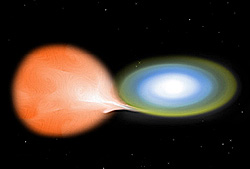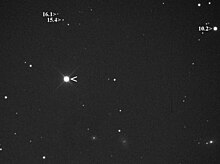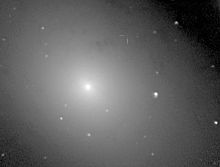Nova

Anova(pl.novaeornovas) is atransient astronomical eventthat causes the sudden appearance of a bright, apparently "new" star (hence the name "nova", Latin for "new" ) that slowly fades over weeks or months. All observed novae involvewhite dwarfsin closebinary systems,but causes of the dramatic appearance of a nova vary, depending on the circumstances of the two progenitor stars. The main sub-classes of novae are classical novae, recurrent novae (RNe), anddwarf novae.They are all considered to becataclysmic variable stars.
Classical nova eruptions are the most common type. This type is usually created in a close binary star system consisting of a white dwarf and either amain sequence,subgiant,orred giant star.If the orbital period of the system is a few days or less, the white dwarf is close enough to its companion star to drawaccretedmatter onto its surface, creating a dense but shallowatmosphere.This atmosphere, mostly consisting of hydrogen, is heated by the hot white dwarf and eventually reaches a critical temperature, causing ignition of rapidrunawayfusion.The sudden increase in energy expels the atmosphere into interstellar space, creating the envelope seen as visible light during the nova event. In past centuries such an event was thought to be a new star. A few novae produce short-livednova remnants,lasting for perhaps several centuries.
A recurrent nova involves the same processes as a classical nova, except that the nova event repeats in cycles of a few decades or less as the companion star again feeds the dense atmosphere of the white dwarf after each ignition, as in the starT Coronae Borealis.
Under certain conditions, mass accretion can eventually trigger runaway fusion that destroys the white dwarf rather than merely expelling its atmosphere. In this case, the event is usually classified as aType Ia supernova.
Novae most often occur in the sky along the path of theMilky Way,especially near the observedGalactic Centerin Sagittarius; however, they can appear anywhere in the sky. They occur far morefrequentlythan galacticsupernovae,averaging about ten per year in the Milky Way. Most are found telescopically, perhaps only one every 12–18 months reachingnaked-eyevisibility. Novae reaching first or secondmagnitudeoccur only a few times per century. The last bright nova wasV1369 Centauri,which reached 3.3 magnitude on 14 December 2013.[1]
Etymology[edit]
During the sixteenth century, astronomerTycho Braheobserved thesupernovaSN 1572in theconstellationCassiopeia.He described it in his bookDe nova stella(Latinfor "concerning the new star" ), giving rise to the adoption of the namenova.In this work he argued that a nearby object should be seen to move relative to the fixed stars, and thus the nova had to be very far away. Although SN 1572 was later found to be a supernova and not a nova, the terms were considered interchangeable until the 1930s.[2]After this, novae were calledclassical novaeto distinguish them from supernovae, as their causes and energies were thought to be different, based solely on the observational evidence.
Although the term "stella nova" means "new star", novae most often take place onwhite dwarfs,which are remnants of extremely old stars.
Stellar evolution of novae[edit]

Evolution of potential novae begins with twomain sequencestars in a binary system. One of the twoevolvesinto ared giant,leaving its remnant white dwarf core in orbit with the remaining star. The second star—which may be either a main-sequence star or an aging giant—begins to shed its envelope onto its white dwarf companion when it overflows itsRoche lobe.As a result, the white dwarf steadily captures matter from the companion's outer atmosphere in an accretion disk, and in turn, the accreted matter falls into the atmosphere. As the white dwarf consists ofdegenerate matter,the accreted hydrogen is unable to expand even though its temperature increases. Runaway fusion occurs when the temperature of this atmospheric layer reaches ~20 millionK,initiating nuclear burning via theCNO cycle.[3]
If the accretion rate is just right, hydrogen fusion may occur in a stable manner on the surface of the white dwarf, giving rise to asupersoft X-ray source,but for most binary system parameters, the hydrogen burning is thermally unstable and rapidly converts a large amount of the hydrogen into other, heavierchemical elementsin arunawayreaction,[2]liberating an enormous amount of energy. This blows the remaining gases away from the surface of the white dwarf and produces an extremely bright outburst of light.
The rise to peak brightness may be very rapid, or gradual; after the peak, the brightness declines steadily.[4]The time taken for a nova to decay by 2 or 3 magnitudes from maximum optical brightness is used for grouping novae into speed classes. Fast novae typically will take less than 25 days to decay by 2 magnitudes, while slow novae will take more than 80 days.[5]
Despite its violence, usually the amount of material ejected in a nova is only about1⁄10,000of asolar mass,quite small relative to the mass of the white dwarf. Furthermore, only five percent of the accreted mass is fused during the power outburst.[2]Nonetheless, this is enough energy to accelerate nova ejecta to velocities as high as several thousand kilometers per second—higher for fast novae than slow ones—with a concurrent rise inluminosityfrom a few times solar to 50,000–100,000 times solar.[2][6]In 2010 scientists using NASA'sFermi Gamma-ray Space Telescopediscovered that a nova also can emitgamma rays(>100 MeV).[7]
Potentially, a white dwarf can generate multiple novae over time as additional hydrogen continues to accrete onto its surface from its companion star. Where this repeated flaring is observed, the object is called a recurrent nova. An example isRS Ophiuchi,which is known to have flared seven times (in 1898, 1933, 1958, 1967, 1985, 2006, and 2021). Eventually, the white dwarf can explode as aType Ia supernovaif it approaches theChandrasekhar limit.
Occasionally, novae are bright enough and close enough to Earth to be conspicuous to the unaided eye. The brightest recent example wasNova Cygni 1975.This nova appeared on 29 August 1975, in the constellationCygnusabout 5 degrees north ofDeneb,and reachedmagnitude2.0 (nearly as bright as Deneb). The most recent wereV1280 Scorpii,which reached magnitude 3.7 on 17 February 2007, andNova Delphini 2013.Nova Centauri 2013was discovered 2 December 2013 and so far is the brightest nova of this millennium, reaching magnitude 3.3.
Helium novae[edit]
A helium nova (undergoing ahelium flash) is a proposed category of nova event that lackshydrogen linesin itsspectrum.The absence of hydrogen lines may be caused by the explosion of a helium shell on a white dwarf. The theory was first proposed in 1989, and the first candidate helium nova to be observed wasV445 Puppis,in 2000.[8]Since then, four other novae have been proposed as helium novae.[9]
Occurrence rate and astrophysical significance[edit]
Astronomers have estimated that theMilky Wayexperiences roughly 25 to 75 novae per year.[10]The number of novae actually observed in the Milky Way each year is much lower, about 10,[11]probably because distant novae are obscured by gas and dust absorption.[11]As of 2019, 407 probable novae had been recorded in the Milky Way.[11]In theAndromeda Galaxy,roughly 25 novae brighter than about 20th magnitude are discovered each year, and smaller numbers are seen in other nearby galaxies.[12]
Spectroscopicobservation of nova ejectanebulaehas shown that they are enriched in elements such as helium, carbon, nitrogen, oxygen, neon, and magnesium.[2]Classical nova explosions are galactic producers of the elementlithium.[13][14]The contribution of novae to theinterstellar mediumis not great; novae supply only1⁄50as much material to the galaxy as do supernovae, and only1⁄200as much asred giantandsupergiantstars.[2]
Observed recurrent novae such asRS Ophiuchi(those with periods on the order of decades) are rare. Astronomers theorize, however, that most, if not all, novae recur, albeit on time scales ranging from 1,000 to 100,000 years.[15]The recurrence interval for a nova is less dependent on the accretion rate of the white dwarf than on its mass; with their powerful gravity, massive white dwarfs require less accretion to fuel an eruption than lower-mass ones.[2]Consequently, the interval is shorter for high-mass white dwarfs.[2]
V Sagittaeis unusual in that the time of its next eruption can be predicted fairly accurately; it is expected to recur in approximately 2083, plus or minus about 11 years.[16]
Subtypes[edit]
Novae are classified according to thelight curvedecay speed:
- NA:fast novae, with a rapid brightness increase, followed by a brightness decline of 3 magnitudes—to about1⁄16brightness—within 100 days.[17]
- NB:slow novae, with a brightness decline of 3 magnitudes in 150 days or more.
- NC:very slow novae, also known assymbiotic novae,staying at maximum light for a decade or more and then fading very slowly.
- NR/RN:recurrent novae, where two or more eruptions separated by 80 years or less have been observed.[18]
Remnants[edit]

Some novae leave behind visiblenebulosity,material expelled in the nova explosion or in multiple explosions.[19]
Novae as distance indicators[edit]
Novae have some promise for use asstandard candlemeasurements of distances. For instance, the distribution of theirabsolute magnitudeisbimodal,with a main peak at magnitude −8.8, and a lesser one at −7.5. Novae also have roughly the same absolute magnitude 15 days after their peak (−5.5). Nova-based distance estimates to various nearbygalaxiesandgalaxy clustershave been shown to be of comparable accuracy to those measured withCepheidvariable stars.[20]
Recurrent novae[edit]
Arecurrent nova(RNe) is an object that has been seen to experience repeated nova eruptions. The recurrent nova typically brightens by about 9 magnitudes, whereas a classic nova may brighten by more than 12 magnitudes.[21]
Although it is estimated that as many as a quarter of nova systems experience multiple eruptions, only ten recurrent novae (listed below) have been observed in the Milky Way.[22]
Severalextragalacticrecurrent novae have been observed in theAndromeda Galaxy(M31) and theLarge Magellanic Cloud.One of these extragalactic novae,M31N 2008-12a,erupts as frequently as once every 12 months.
On 20 April 2016, theSky & Telescopewebsite reported a sustained brightening ofT Coronae Borealisfrom magnitude 10.5 to about 9.2 starting in February 2015. A similar event had been reported in 1938, followed by another outburst in 1946.[23]By June 2018, the star had dimmed slightly but still remained at an unusually high level of activity. In March or April 2023, it dimmed to magnitude 12.3.[24]A similar dimming occurred in the year before the 1945 outburst, indicating that it will likely erupt between March and September 2024.[25]
| Full name |
Discoverer |
Distance (ly) | Magnitude range |
Days to drop 3 magnitudes from peak |
Known eruption years | Time span (years) | Years since latest eruption |
|---|---|---|---|---|---|---|---|
| CI Aquilae | K. Reinmuth | 8590±830 | 8.6–16.3 | 40 | 1917, 1941, 2000 | 24–59 | 24 |
| V394 Coronae Australis | L. E. Erro | 17000±3000[26] | 7.2–19.7 | 6 | 1949, 1987 | 38 | 36 |
| T Coronae Borealis | J. Birmingham | 2987±75 | 2.5–10.8 | 6 | 1217, 1787, 1866, 1946 | 80 | 78 |
| IM Normae | I. E. Woods | 9800±1600[27] | 8.5–18.5 | 70 | 1920, 2002 | ≤82 | 22 |
| RS Ophiuchi | W. Fleming | 8740±850 | 4.8–11 | 14 | 1898, 1907, 1933, 1958, 1967, 1985, 2006, 2021 | 9–26 | 2 |
| V2487 Ophiuchi | K. Takamizawa(1998) | 20900±5200[28] | 9.5–17.5 | 9 | 1900, 1998 | 98 | 26 |
| T Pyxidis | H. Leavitt | 9410±780 | 6.4–15.5 | 62 | 1890, 1902, 1920, 1944, 1967, 2011 | 12–44 | 13 |
| V3890 Sagittarii | H. Dinerstein | 16000[29] | 8.1–18.4 | 14 | 1962, 1990, 2019 | 28–29 | 4 |
| U Scorpii | N. R. Pogson | 31300±2000[30] | 7.5–17.6 | 2.6 | 1863, 1906, 1917, 1936, 1979, 1987, 1999, 2010, 2022, | 8–43 | 2 |
| V745 Scorpii | L. Plaut | 25400±2600[30] | 9.4–19.3 | 7 | 1937, 1989, 2014 | 25–52 | 10 |
Extragalactic novae[edit]

Novae are relatively common in theAndromeda Galaxy(M31); several dozen novae (brighter thanapparent magnitude+20) are discovered in M31 each year.[12]TheCentral Bureau for Astronomical Telegrams(CBAT) has tracked novae in M31,M33,andM81.[31]
See also[edit]
References[edit]
- ^"Nova Centauri 2013: Another bright, naked-eye nova | aavso.org".www.aavso.org.Retrieved2 November2020.
- ^abcdefghPrialnik, Dina (2001). "Novae". In Paul Murdin (ed.).Encyclopedia of Astronomy and Astrophysics.Institute of Physics Publishing/Nature Publishing Group.pp. 1846–1856.ISBN978-1-56159-268-5.
- ^M.J. Darnley; et al. (10 February 2012). "On the Progenitors of Galactic Novae".The Astrophysical Journal.746(61): 61.arXiv:1112.2589.Bibcode:2012ApJ...746...61D.doi:10.1088/0004-637x/746/1/61.S2CID119291027.
- ^AAVSOVariable Star Of The Month:May 2001: NovaeArchived6 November 2003 at theWayback Machine
- ^ Warner, Brian (1995).Cataclysmic Variable Stars.Cambridge University Press.ISBN978-0-521-41231-5.
- ^ Zeilik, Michael (1993).Conceptual Astronomy.John Wiley & Sons.ISBN978-0-471-50996-7.
- ^ JPL/NASA(12 August 2010)."Fermi detects 'shocking' surprise from supernova's little cousin".PhysOrg.Retrieved15 August2010.
- ^Kato, Mariko; Hachisu, Izumi (December 2005). "V445 Puppis: Helium Nova on a Massive White Dwarf".The Astrophysical Journal.598(2): L107–L110.arXiv:astro-ph/0310351.Bibcode:2003ApJ...598L.107K.doi:10.1086/380597.S2CID17055772.
- ^Rosenbush, A. E. (17–21 September 2007). Klaus Werner; Thomas Rauch (eds.). "List of Helium Novae".Hydrogen-Deficient Stars.391.Eberhard Karls University, Tübingen, Germany (published July 2008): 271.Bibcode:2008ASPC..391..271R.
- ^Shafter, A.W. (January 2017)."The Galactic Nova Rate Revisited".The Astrophysical Journal.834(2): 192–203.arXiv:1606.02358.Bibcode:2017ApJ...834..196S.doi:10.3847/1538-4357/834/2/196.S2CID118652484.
- ^abc "CBAT List of Novae in the Milky Way".IAUCentral Bureau for Astronomical Telegrams.
- ^ab "M31 (Apparent) Novae Page".IAUCentral Bureau for Astronomical Telegrams.Retrieved24 February2009.
- ^Arizona State University(1 June 2020)."Class of stellar explosions found to be galactic producers of lithium".EurekAlert!.Retrieved2 June2020.
- ^Starrfield, Sumner;et al. (27 May 2020)."Carbon–Oxygen Classical Novae Are Galactic 7Li Producers as well as Potential Supernova Ia Progenitors".The Astrophysical Journal.895(1): 70.arXiv:1910.00575.Bibcode:2020ApJ...895...70S.doi:10.3847/1538-4357/ab8d23.S2CID203610207.
- ^ Seeds, Michael A. (1998).Horizons: Exploring the Universe(5th ed.).Wadsworth Publishing Company.p. 194.ISBN978-0-534-52434-0.
- ^"Binary star V Sagittae to explode as very bright nova by century's end".phys.org.Retrieved20 January2020.
- ^ "Ritter Cataclysmic Binaries Catalog (7th Edition, Rev. 7.13)".High Energy Astrophysics Science Archive Research Center.31 March 2010.Retrieved25 September2010.
- ^GCVS' vartype.txtatVizieR
- ^Liimets, T.; Corradi, R.L.M.; Santander-García, M.; Villaver, E.; Rodríguez-Gil, P.; Verro, K.; Kolka, I. (2014). "A Dynamical Study of the Nova Remnant of GK Persei / Stella Novae: Past and Future Decades.".Stellar Novae: Past and Future Decades.ASP Conference Series. Vol. 490. pp. 109–115.arXiv:1310.4488.Bibcode:2014ASPC..490..109L.
- ^ Robert, Gilmozzi; Della Valle, Massimo (2003). "Novae as Distance Indicators". In Alloin, D.; Gieren, W. (eds.).Stellar Candles for the Extragalactic Distance Scale.Springer.pp.229–241.ISBN978-3-540-20128-1.
- ^ Schaefer, Bradley E. (2010). "Comprehensive Photometric Histories of All Known Galactic Recurrent Novae".The Astrophysical Journal Supplement Series.187(2): 275–373.arXiv:0912.4426.Bibcode:2010ApJS..187..275S.doi:10.1088/0067-0049/187/2/275.S2CID119294221.
- ^Pagnotta, Ashley; Schaefer, Bradley E. (2014). "Identifying and Quantifying Recurrent Novae Masquerading as Classical Novae".The Astrophysical Journal.788(2): 164.arXiv:1405.0246.Bibcode:2014ApJ...788..164P.doi:10.1088/0004-637X/788/2/164.S2CID118448146.
- ^"Is T CrB About to Blow its Top?".Sky & Telescope website. 20 April 2016.Retrieved6 August2017.
- ^Schaefer, B.E.; Kloppenborg, B.; Waagen, E.O."Announcing T CrB pre-eruption dip".AAVSO.American Association of Variable Star Observers.Retrieved18 January2024.
- ^Todd, Ian."T Coronae Borealis nova event guide and how to prepare".Sky at Night Magazine.BBC.Retrieved18 March2024.
- ^Hachisu, Izumi; Kato, Mariko (September 2000)."A Theoretical Light-Curve Model for the Recurrent Nova V394 Coronae Australis".The Astrophysical Journal.540(1): 447–451.arXiv:astro-ph/0003471.Bibcode:2000ApJ...540..447H.doi:10.1086/309338.Retrieved3 May2024.
- ^Patterson, Joseph; Kemp, Jonathan; Monard, Berto; Myers, Gordon; de Miguel, Enrique; Hambsch, Franz-Josef; Warhurst, Paul; Rea, Robert; Dvorak, Shawn; Menzies, Kenneth; Vanmunster, Tonny; Roberts, George; Campbell, Tut; Starkey, Donn; Ulowetz, Joseph; Rock, John; Seargeant, Jim; Boardman, James; Lemay, Damien; Cejudo, David; Knigge, Christian (1 January 2022)."IM Normae: The Death Spiral of a Cataclysmic Variable?".The Astrophysical Journal.924(1): 27.arXiv:2010.07812.Bibcode:2022ApJ...924...27P.doi:10.3847/1538-4357/abec87.
- ^Rodríguez-Gil, Pablo; Corral-Santana, Jesús M; Elías-Rosa, N; Gänsicke, Boris T; Hernanz, Margarita; Sala, Gloria (20 October 2023)."The orbital period of the recurrent nova V2487 Oph revealed".Monthly Notices of the Royal Astronomical Society.526(4): 4961–4975.arXiv:2310.05877.doi:10.1093/mnras/stad3124.Retrieved3 May2024.
- ^Anupama, G. C.; Sethi, S. (1 July 1994)."Spectroscopy of the recurrent nova V3890 Sagittarii 18 d after the 1990 outburst".Monthly Notices of the Royal Astronomical Society.269(1): 105–109.doi:10.1093/mnras/269.1.105.Retrieved3 May2024.
- ^abHachisu, Izumi; Kato, Mariko (1 April 2016)."THE UBV COLOR EVOLUTION OF CLASSICAL NOVAE. II. COLOR–MAGNITUDE DIAGRAM".The Astrophysical Journal Supplement Series.223(2): 21.arXiv:1602.01195.Bibcode:2016ApJS..223...21H.doi:10.3847/0067-0049/223/2/21.
- ^ Bishop, David."Extragalactic Novae".International Supernovae Network.Retrieved11 September2010.
Further reading[edit]
- Payne-Gaposchkin, C. (1957).The Galactic Novae.North Holland Publishing Co.
- Hernanz, M.; Josè, J. (2002).Classical Nova Explosions.American Institute of Physics.
- Bode, M.F.; Evans, E. (2008).Classical Novae.Cambridge University Press.
- Schaefer (2010). "Comprehensive Photometric Histories of All Known Galactic Recurrent Novae".The Astrophysical Journal Supplement Series.187(2): 275–373.arXiv:0912.4426.Bibcode:2010ApJS..187..275S.doi:10.1088/0067-0049/187/2/275.S2CID119294221.
- Shafter; et al. (2011). "A Spectroscopic and Photometric Survey of Novae in M31".The Astrophysical Journal.734(1): 12.arXiv:1104.0222.Bibcode:2011ApJ...734...12S.doi:10.1088/0004-637X/734/1/12.S2CID119114867.
- Massimo Della Valle; Luca Izzo (30 April 2020). "Observations of Galactic and Extragalactic Novae".Astronomy and Astrophysics Review.28(1): 3.arXiv:2004.06540.Bibcode:2020A&ARv..28....3D.doi:10.1007/s00159-020-0124-6.S2CID215754507.

